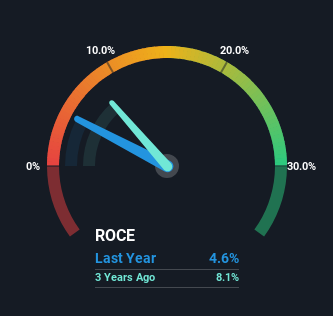- United Kingdom
- /
- Machinery
- /
- LSE:TRI
Trifast's (LON:TRI) Returns On Capital Not Reflecting Well On The Business
Finding a business that has the potential to grow substantially is not easy, but it is possible if we look at a few key financial metrics. Ideally, a business will show two trends; firstly a growing return on capital employed (ROCE) and secondly, an increasing amount of capital employed. Ultimately, this demonstrates that it's a business that is reinvesting profits at increasing rates of return. Although, when we looked at Trifast (LON:TRI), it didn't seem to tick all of these boxes.
Return On Capital Employed (ROCE): What Is It?
If you haven't worked with ROCE before, it measures the 'return' (pre-tax profit) a company generates from capital employed in its business. To calculate this metric for Trifast, this is the formula:
Return on Capital Employed = Earnings Before Interest and Tax (EBIT) ÷ (Total Assets - Current Liabilities)
0.046 = UK£10m ÷ (UK£265m - UK£44m) (Based on the trailing twelve months to March 2023).
So, Trifast has an ROCE of 4.6%. In absolute terms, that's a low return and it also under-performs the Machinery industry average of 14%.
Check out our latest analysis for Trifast

In the above chart we have measured Trifast's prior ROCE against its prior performance, but the future is arguably more important. If you'd like, you can check out the forecasts from the analysts covering Trifast here for free.
What The Trend Of ROCE Can Tell Us
On the surface, the trend of ROCE at Trifast doesn't inspire confidence. Over the last five years, returns on capital have decreased to 4.6% from 15% five years ago. Although, given both revenue and the amount of assets employed in the business have increased, it could suggest the company is investing in growth, and the extra capital has led to a short-term reduction in ROCE. And if the increased capital generates additional returns, the business, and thus shareholders, will benefit in the long run.
On a side note, Trifast has done well to pay down its current liabilities to 17% of total assets. So we could link some of this to the decrease in ROCE. What's more, this can reduce some aspects of risk to the business because now the company's suppliers or short-term creditors are funding less of its operations. Since the business is basically funding more of its operations with it's own money, you could argue this has made the business less efficient at generating ROCE.
What We Can Learn From Trifast's ROCE
Even though returns on capital have fallen in the short term, we find it promising that revenue and capital employed have both increased for Trifast. However, despite the promising trends, the stock has fallen 62% over the last five years, so there might be an opportunity here for astute investors. So we think it'd be worthwhile to look further into this stock given the trends look encouraging.
One more thing to note, we've identified 1 warning sign with Trifast and understanding it should be part of your investment process.
While Trifast may not currently earn the highest returns, we've compiled a list of companies that currently earn more than 25% return on equity. Check out this free list here.
Valuation is complex, but we're here to simplify it.
Discover if Trifast might be undervalued or overvalued with our detailed analysis, featuring fair value estimates, potential risks, dividends, insider trades, and its financial condition.
Access Free AnalysisHave feedback on this article? Concerned about the content? Get in touch with us directly. Alternatively, email editorial-team (at) simplywallst.com.
This article by Simply Wall St is general in nature. We provide commentary based on historical data and analyst forecasts only using an unbiased methodology and our articles are not intended to be financial advice. It does not constitute a recommendation to buy or sell any stock, and does not take account of your objectives, or your financial situation. We aim to bring you long-term focused analysis driven by fundamental data. Note that our analysis may not factor in the latest price-sensitive company announcements or qualitative material. Simply Wall St has no position in any stocks mentioned.
About LSE:TRI
Trifast
Designs, engineers, manufactures, and supplies industrial fasteners and category C components in the United Kingdom, Ireland, Europe, North America, and Asia.
Excellent balance sheet with moderate growth potential.
Market Insights
Community Narratives



